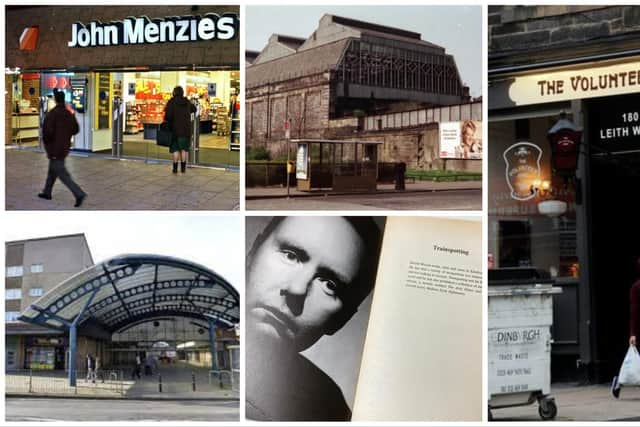Trainspotting at 30: 5 Edinburgh locations in Irvine Welsh's cult novel which have changed beyond recognition
and live on Freeview channel 276
Trainspotting is celebrating its 30th anniverary this year – and so much has changed in Edinburgh since the publication of Irvine Welsh’s scabrous novel.
Now regarded as a stone-cold classic, the darkly-comic tale of a group of heroin addicts in Eighties Edinburgh was seminal, infinitely quotable, and made household names of its young stars when it was later adapted for the big screen by Danny Boyle.
Advertisement
Hide AdAdvertisement
Hide AdA far cry from the picture-postcard Edinburgh seen in holiday brochures, Trainspotting, with its mean streets, drug-ridden council estates, and dodgy toilets showed the world a gritty side of Scotland's capital they had never seen before.


So, just how different is the city now, and would Rents, Spud, Begbie and Co. still recognise it?
Let’s take a look at some of Trainspotting’s most memorable locations to find out...
Trainspotting at Leith Central Station
We’re introduced to the former North British Railways terminus in the chapter appropriately titled ‘Trainspotting at Leith Central Station’.
Advertisement
Hide AdAdvertisement
Hide AdTowards the end of the chapter, two of the book’s main characters take a detour at the foot of Leith Walk to ‘relieve’ themselves at the disused Central Station, which Welsh, through the voice of Renton, describes as a “barren, desolate hangar, soon tae be demolished”.
The chapter is notable for the inclusion of an old drunk, wine bottle in hand, who wanders up to Renton and Begbie to quip: “What yis up tae lads? Trainspottin, eh?”. *Spoiler alert* It is later revealed that the old man is Begbie’s father.
Today, Leith Central Station is long gone. The old station was demolished soon after Renton and Begbie’s visit and later replaced by a supermarket and Leith Waterworld swim centre (now a soft play centre). The famous Central Bar and the high station walls which form the perimeter of the supermarket’s car park are just two of the station’s visible remnants.
‘The worst toilet in Scotland’
Early on in both the book and film adaptations, Renton, struggling to contain his bowels, makes a frenzied dash to the nearest loo. Situated at the back of a bookies in Muirhouse Shopping Centre on Pennywell Road, it turns out to be ‘the worst toilet in Scotland’ which Irvine Welsh describes in lurid detail as a kind of open sewer, leaving very little to the imagination.
Advertisement
Hide AdAdvertisement
Hide AdThe bookmaker’s used in Trainspotting later became Telford Learning Centre. We live in hope that those toilets are history.
The ‘Volly’ Arms
One of the pubs featured prominently in Trainspotting is the Volunteer Arms, a proper working man’s boozer with a rough reputation, situated towards the foot of Leith Walk.
Known to locals as ‘the Volly’, the pub is referenced as the location where “it all goes wrong big time”, when Begbie assaults a man at the bar after losing a game of pool.
The Volly underwent a £70,000 transformation in 2014 to reopen as the Cask & Still, a trendy whisky bar intent on capturing a whole new clientele.
Advertisement
Hide AdAdvertisement
Hide AdLast year the pub was renamed again as The Mousetrap. It now features a mural on the side of its exterior recalling its Trainspotting links, but don’t go looking for a pool table, because there isn’t one.
Easter Road stadium
Irvine Welsh reserves a special place in his heart for Hibernian FC, so unsurprisngly it’s the team of choice for his Trainspotting characters – all of whom hail from in or around the Leith area.
In the chapter entitled Victory On New Year’s Day, Renton, Tommy, Begbie and friends head to Easter Road for the traditional Ne’erday derby against Edinburgh rivals Hearts. Welsh, intent on starving his characters of pretty much any form of joy during the novel – no matter how trivial – concocts a 4-1 win for the Jambos.
Influenced by the Taylor Report which saw all major UK stadia become all-seater in the 1990s, Hibs’ ground has changed massively since Trainspotting was penned. Easter Road’s famous sloping pitch was smoothed out in 2000, and its deteriorated terracing replaced by four shiny new stands, making the ground unrecognisable to how it would have looked 30-odd years ago.
A Lust For Life
Advertisement
Hide AdAdvertisement
Hide AdWithout question, the most iconic scene in the movie version of Trainspotting is its pulsating opening which sees Renton and Spud race on foot along Princes Street, followed in hot pursuit by a pair of John Menzies’ security guards.
Set to Iggy Pop’s Lust For Life, the memorable scene is inspired by various references to Spud’s ubiquitous shoplifting habit throughout the novel. Spud ends up serving time for a spate of thefts, which include the procurement of fancy cushions from BHS and a “set ay blank tapes” from Woolies at the Kirkgate. Funnily enough, all three of the stores mentioned have folded. We’re looking at you, Spud…
Comment Guidelines
National World encourages reader discussion on our stories. User feedback, insights and back-and-forth exchanges add a rich layer of context to reporting. Please review our Community Guidelines before commenting.
